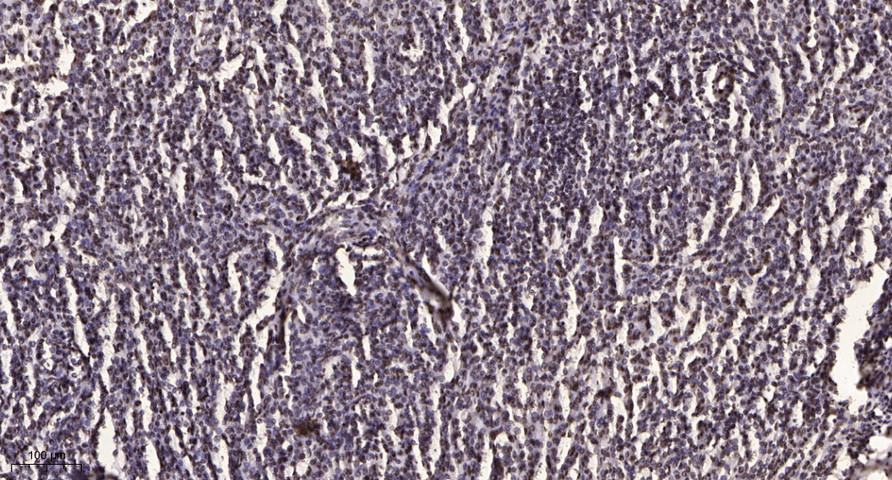Bamacan (Phospho Ser1083) Polyclonal Antibody
- Catalog No.:YP1228
- Applications:IHC;IF;WB
- Reactivity:Human;Mouse;Rat
- Target:
- SMC3
- Fields:
- >>Cell cycle;>>Oocyte meiosis
- Gene Name:
- SMC3 BAM BMH CSPG6 SMC3L1
- Protein Name:
- Bamacan (Phospho-Ser1083)
- Human Gene Id:
- 9126
- Human Swiss Prot No:
- Q9UQE7
- Immunogen:
- Synthesized peptide derived from human Bamacan (Phospho-Ser1083)
- Specificity:
- This antibody detects endogenous phospho levels of Bamacan (Phospho-Ser1083) at Human:S1083, Mouse:S1083, Rat:S1083
- Formulation:
- Liquid in PBS containing 50% glycerol, 0.5% BSA and 0.02% sodium azide.
- Source:
- Polyclonal, Rabbit,IgG
- Dilution:
- IHC 1:50-200, WB 1:500-2000. IF 1:50-200
- Purification:
- The antibody was affinity-purified from rabbit serum by affinity-chromatography using specific immunogen.
- Concentration:
- 1 mg/ml
- Storage Stability:
- -15°C to -25°C/1 year(Do not lower than -25°C)
- Other Name:
- Structural maintenance of chromosomes protein 3 (SMC protein 3;SMC-3;Basement membrane-associated chondroitin proteoglycan;Bamacan;Chondroitin sulfate proteoglycan 6;Chromosome-associated polypeptide;hCAP)
- Observed Band(KD):
- 145kD
- Background:
- This gene belongs to the SMC3 subfamily of SMC proteins. The encoded protein occurs in certain cell types as either an intracellular, nuclear protein or a secreted protein. The nuclear form, known as structural maintenance of chromosomes 3, is a component of the multimeric cohesin complex that holds together sister chromatids during mitosis, enabling proper chromosome segregation. Post-translational modification of the encoded protein by the addition of chondroitin sulfate chains gives rise to the secreted proteoglycan bamacan, an abundant basement membrane protein. [provided by RefSeq, Jul 2008],
- Function:
- caution:Was originally isolated as a proteoglycan protein (explaining its name). Although not excluded, such secreted function is not clear.,disease:Defects in SMC3 are the cause of Cornelia de Lange syndrome type 3 (CDLS3) [MIM:610759]. CDLS is a dominantly inherited multisystem developmental disorder characterized by growth and cognitive retardation, abnormalities of the upper limbs, gastroesophageal dysfunction, cardiac, ophthalmologic and genitourinary anomalies, hirsutism, and characteristic facial features. CDSL3 is a mild form with absence of major structural anomalies typically associated with CDLS. The phenotype in some instances approaches that of apparently non-syndromic mental retardation.,domain:The flexible hinge domain, which separates the large intramolecular coiled coil regions, allows the heterotypic interaction with the corresponding domain of SMC1A or SMC1B, forming a
- Subcellular Location:
- Nucleus . Chromosome . Chromosome, centromere . Associates with chromatin. Before prophase it is scattered along chromosome arms. During prophase, most of cohesin complexes dissociate from chromatin probably because of phosphorylation by PLK, except at centromeres, where cohesin complexes remain. At anaphase, the RAD21 subunit of the cohesin complex is cleaved, leading to the dissociation of the complex from chromosomes, allowing chromosome separation. The phosphorylated form at Ser-1083 is preferentially associated with unsynapsed chromosomal regions (By similarity). .
- Expression:
- B-cell,Epithelium,Eye,Neuron,Umbilical cord blood,
- June 19-2018
- WESTERN IMMUNOBLOTTING PROTOCOL
- June 19-2018
- IMMUNOHISTOCHEMISTRY-PARAFFIN PROTOCOL
- June 19-2018
- IMMUNOFLUORESCENCE PROTOCOL
- September 08-2020
- FLOW-CYTOMEYRT-PROTOCOL
- May 20-2022
- Cell-Based ELISA│解您多样本WB检测之困扰
- July 13-2018
- CELL-BASED-ELISA-PROTOCOL-FOR-ACETYL-PROTEIN
- July 13-2018
- CELL-BASED-ELISA-PROTOCOL-FOR-PHOSPHO-PROTEIN
- July 13-2018
- Antibody-FAQs
- Products Images

- Immunohistochemical analysis of paraffin-embedded human brain tumor. 1, Antibody was diluted at 1:200(4° overnight). 2, Tris-EDTA,pH9.0 was used for antigen retrieval. 3,Secondary antibody was diluted at 1:200(room temperature, 45min).



